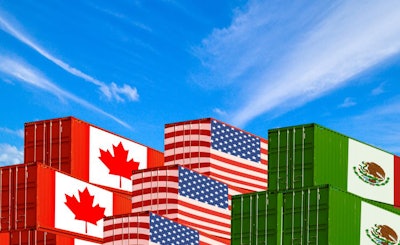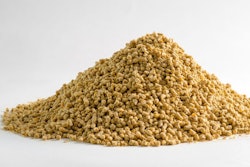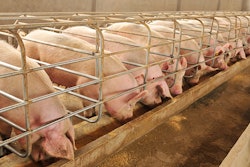
The United States-Mexico-Canada trade deal extends, improves upon provisions from NAFTA
Experts agree that the United States-Mexico-Canada Agreement (USMCA) is beneficial to the U.S. animal feed industry, as it extends many provisions from the North American Free Trade Agreement (NAFTA) but also includes improvements.
The trade deal, also called the New NAFTA, went into effect on July 1 and is set to expire after 16 years.
“USMCA is a good agreement because it provides certainty and continues the free trade that grain and feed producers in the U.S., Canada and Mexico have enjoyed since the signing of NAFTA,” said U.S. Grains Council (USGC) president and CEO, Ryan LeGrand.
In addition to preserving duty-free trade market access, Gina Tumbarello, director of international policy and trade at the American Feed Industry Association (AFIA), said that “the modernized agreement lays the groundwork for exports of new technologies and ingredients that could improve animal health and nutrition.”
According to AFIA, U.S. animal food exports to Canada and Mexico nearly quadrupled since NAFTA was enacted in 1994 from US$669 million to US$3.3 billion in 2019, and the industry will see continued growth as a result of USMCA.
“With USMCA in place and currently being implemented, grain and feed producers in all three countries can continue to count on their cross-border customers as a solid source of demand,” LeGrand said.
Max Fisher, vice president of economics and government relations at the National Grain and Feed Association (NGFA), said the improvements made to USMCA compared with NAFTA are mostly in trade rules, as opposed to tariffs.
“USMCA requires higher levels of regulatory coherence and cooperation, the implementation of timelines and notifications for adverse import checks, the use of technical consultations for sanitary and phytosanitary (SPS) disputes, and that SPS standards be grounded in science and based on proper risk assessments and implemented using accepted risk management techniques,” he said. “Removing non-tariff barriers is positive for North American animal feed and livestock producers, especially U.S. producers, due to their competitive advantage.”
He added that, because “most of the changes are on trade rules, the effects are likely to be less visible, but important, nonetheless. For example, the new USMCA rules will make it more difficult for a customs official to delay or reject an individual shipment without just cause. By helping prevent trade irritants and other barriers, more consistent, robust trade is possible.”
Improvements to sanitary and phytosanitary standards
The key change to the rules for the animal feed industry is in the sanitary and phytosanitary, or SPS, standards that Fisher mentioned. SPS measures protect humans, animals and plants from diseases, pests or contaminants. Tumbarello pointed out that the USMCA’s SPS standards are stronger than those under the World Trade Organization (WTO), and the U.S. can use them as a model for future trade agreements with other countries.
“While the North American Free Trade Agreement included some SPS measures, it was not formally written into the text of the trilateral agreement since the WTO SPS agreement went into effect after NAFTA’s implementation,” she said. “The U.S.-Mexico-Canada Agreement fixed this by explicitly recognizing the WTO SPS agreement, bringing it more in line with other U.S. trade agreements and allowing for an enforceable mechanism on SPS measures for multilateral trade.”
Experts said the updated standards will improve trade in the region.
“There’s a lot of positives in the sanitary and phytosanitary (SPS) section of USMCA, such as ensuring each country’s respective SPS measures are based on scientific principles and attempting to enhance the compatibility of each party’s measures to facilitate trade,” Fisher said. “A major reform we believe will help facilitate trade is the addition of specific actions and timelines for importing parties when shipments are detained by importing officials. For detained shipments, USMCA requires the importing party to provide notification within five days that includes the reason for the detainment, the legal basis or authorization of the action and information on the status of the shipment (see sidebar). These are new transparency requirements that we believe will enhance trade.”
Addressing 21st century innovations
American Farm Bureau Federation (AFBF) economist Veronica Nigh said the USMCA also addresses agricultural biotechnology, which has vastly changed since the enactment of NAFTA.
“For the first time, the agreement specifically addresses agricultural biotechnology to support 21st century innovations in agriculture,” she said. “The text covers all biotechnologies, including new technologies such as gene editing. Specifically, the United States, Mexico and Canada have agreed to provisions to enhance information exchange and cooperation on agricultural biotechnology trade-related matters.”
Nigh added that changes to de minimis shipment values would benefit small and medium-sized businesses. A de minimis value is the threshold under which shipments are duty-free.
“To facilitate greater cross-border trade, the United States has reached an agreement with Mexico and Canada to raise their de minimis shipment value levels that will help reduce costs and bring greater ease and predictability to cross-border transactions,” she said. “USMCA raises the de minimis level for Canada for express shipments for the first time in decades, with up to CAD40 exempt from duties and taxes (increased from CAD20) and up to CAD150 exempt from duties. USMCA sets the de minimis level for Mexico up to US$50 exempt from duties and taxes and raises it up to US$117 duty-free for express shipments. Shipment values up to these levels would enter with minimal formal entry procedures, making it easier for more businesses, especially small- and medium-sized ones, to be a part of cross-border trade.
“Additionally, USMCA creates a new informal shipment level of US$2,500, so that express shipments under that amount benefit from reduced paperwork. This will allow businesses to send samples of their product more easily.”
Long-term expectations
Over the long term, LeGrand said, the U.S., Mexico and Canada can expect to see increased collaboration and expanded trade as a result of the deal.
USMCA “will further enhance interregional trade, integrate our markets and solidify our collective ability to remain the most competitive platform for global trade in livestock and poultry products,” he said.
Tumbarello agreed, adding that trade expansion opportunities will benefit the agriculture industry.
“Being able to maintain our relationship with current trading partners while seeking new ones only continues to further our ability to export some of our efficient processes and innovative products that will continue to improve agriculture’s role in society,” she said.
USMCA’s rules on import checks
Under the USMCA, if an importing entity prohibits or restricts an imported product because of an “adverse result of an import check,” it must notify the importer or its agent, the exporter or the manufacturer of the result.
In that notification, the importing party must include:
- The reason for the prohibition or restriction
- The legal basis or authorization for the action
- Information on the status of the affected goods including, if applicable:
- Relevant laboratory results and laboratory methodologies, if requested and possible to include
- In the case of pest interceptions, an identification of the pests at the species level, if available
- Information on the disposition of goods, if appropriate
The notification must be transmitted as soon as possible and within five days of the decision to prohibit or restrict, unless the good is seized by a customs administrator or subject to ongoing law enforcement action.












